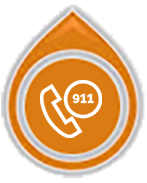Teaching your children how to use 9-1-1

Teaching your children how to use 9-1-1 is crucial and could save their lives or yours. Here are four simple steps for teaching your children, no matter how old they are, how to use 9-1-1:
- First, explain what 9-1-1 is.
- Teach them to assess the risks before dialing 9-1-1.
- Explain what type of information to give once they have called 9-1-1.
- Practice scenarios with them to make them more familiar with the concept without frightening them.
To find out more about how to prepare for a wide range of emergencies, go to Get Prepared.
1) Explain what 9-1-1 is
First, children should be taught when to call 9-1-1. Let them know that they can call this service at any time they think someone is in danger or are seriously injured. Assessing this kind of situation may not be obvious to children, so share some examples. If your children are young, use simple words and avoid medical terms. For example, you could say: "If you see someone lying on the ground not moving, find an adult immediately. If no one is around, call 9-1-1."
If someone close to you has a particular health problem, explain it to your children. Describe the symptoms and tell them what to do in case this person is not feeling well.
2) Assess the risks before calling 9-1-1
Next, your children must be able to determine whether or not it is safe to call 9-1-1 from where they are. Remind them that they must be somewhere safe before calling 9-1-1. For example, tell them that if there is a fire in a room or throughout the house, they are to leave the house immediately and then call 9-1-1. Remember: Calling 9-1-1 from a payphone is free.
Explain that calling 9-1-1 is not a game or a joke. Tell them that every second counts when someone is in danger. An unnecessary 9-1-1 call could prevent someone who is truly in danger from getting help.
3) What to say to 9-1-1
Finally, explain to your children what will happen when they call 9-1-1. Tell them that a man or a woman will ask them whether they need police, fire, or an ambulance and where they are. If your children are young, use words that are easy to understand (such as "ambulance", not "paramedic"). If your children are very young, briefly explain what each service can do in emergencies or instruct them to tell the person on the line that they need help right away.
Teach them that they are then to describe the situation and say where they are.
The location of the emergency is always asked first, then the name, location and phone number of the caller.
4) Practice / role-play
Familiarize children with emergency situations to help reduce panic or anxiety in case of a real emergency.
For example, you can create a game with scenarios for your children to test their knowledge. Adapt scenarios accordingly to your children's age and development. Practice several times a year so that your children are as prepared as possible to deal with emergencies.
Below are three basic scenarios you can use with your children. The answers are provided in brackets.
Scenario #1
- You're playing in the living room when you hear a loud noise from the kitchen. You go to see what's happening and see mom on the floor. What should you do? (Check to see if mom can hear me.)
- Mom answers you, then tries to get up but she can't. She is bleeding a lot. Should you call 9-1-1? (Yes, I have to call 9-1-1 and ask for an ambulance.)
- What do you have to tell 9-1-1? (The Emergency is at 123 X street, X city. My mom fell down, she can still talk but she's bleeding a lot and can't get up. I am calling from 123 X Street, X City. This is also where we live.)
- Can you wait for the ambulance with your mom? (Yes. I'm not in any danger.)
Scenario #2
- You come home from school and see that the door to your house is broken, and you think someone you don't know may be inside. What should you do? (Go to my neighbours' house or use a payphone for free and ask to call 9-1-1.)
- You come home from school and see that the door to your house is broken, and you think someone you don't know may be inside. What should you tell 9-1-1? (Location of the emergency is 123 X street, X city. Someone I don't know broke down the door to my house and might be inside. I need the police. I am at 123 X Street, X City, my neighbours' house and I'm safe.)
- Can you wait for the police? (Yes, but I have to stay at the neighbours', I can't go home to wait for the police).
Scenario #3
- You're playing outside with your older sister and she falls off her bicycle. What should you do? (Check to see if she can hear me.)
- She answers you but says her knee hurts a little. Her knee is bleeding a little bit. Should you call an ambulance? (No, this isn't a serious injury and she is conscious.)
- What should you do? (Go home to clean the injury or go get help from an adult I know.)
Source: Get Prepared: Emergency Preparedness for Children

